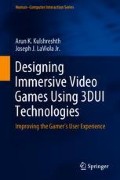Abstract
This chapter summarizes our research experiments, discussed in prior chapters, on utilizing 3D interaction technologies for improving the gaming experience. In the end, we conclude the book.
Access this chapter
Tax calculation will be finalised at checkout
Purchases are for personal use only
References
Kulshreshth A, LaViola JJ Jr (2013) Evaluating performance benefits of head tracking in modern video games. In: Proceedings of the 1st Symposium on Spatial User Interaction. SUI ’13. ACM, New York, NY, USA, pp 55–60. https://doi.org/10.1145/2491367.2491376
Kulshreshth A, LaViola JJ Jr (2014) Exploring the usefulness of finger-based 3D gesture menu selection. In: Proceedings of the SIGCHI Conference on Human Factors in Computing Systems. CHI ’14. ACM, Toronto, Ontario, Canada, pp 1093–1102. https://doi.org/10.1145/2556288.2557122 ISBN: 978-1-4503-2473-1
Kulshreshth A, LaViola JJ Jr (2015) Exploring 3D user interface technologies for improving the gaming experience. In: Proceedings of the SIGCHI Conference on Human Factors in Computing Systems. CHI ’15. ACM, Toronto, Ontario, Canada, pp 124–134 ISBN: 978-1-4503-2473-1
Kulshreshth A, Schild J, LaViola JJ Jr (2012) Evaluating user performance in 3D stereo and motion enabled video games. In: Proceedings of the International Conference on the Foundations of Digital Games. ACM, New York, NY, pp 33–40. https://doi.org/10.1145/2282338.2282350
Litwiller T, LaViola JJ Jr (2011) Evaluating the benefits of 3D stereo in modern video games. In: Proceedings of the SIGCHI Conference on Human Factors in Computing Systems. CHI’11. ACM, New York, NY, USA, pp 2345–2354. https://doi.org/10.1145/1978942.1979286
Rajae-Joordens RJE (2008) Measuring experiences in gaming and TV applications. Probing Experience, vol 8. Philips Research. Springer, Netherlands, pp 77–90 ISBN: 978-1-4020-6593-4
Author information
Authors and Affiliations
Corresponding author
Rights and permissions
Copyright information
© 2018 Springer International Publishing AG, part of Springer Nature
About this chapter
Cite this chapter
Kulshreshth, A.K., LaViola, J.J. (2018). Summary and Conclusion. In: Designing Immersive Video Games Using 3DUI Technologies. Human–Computer Interaction Series. Springer, Cham. https://doi.org/10.1007/978-3-319-77953-9_8
Download citation
DOI: https://doi.org/10.1007/978-3-319-77953-9_8
Published:
Publisher Name: Springer, Cham
Print ISBN: 978-3-319-77952-2
Online ISBN: 978-3-319-77953-9
eBook Packages: Computer ScienceComputer Science (R0)

